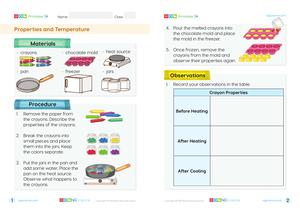Begin the lesson by discussing everyday examples of melting and freezing, such as ice melting on a warm day or water freezing in a freezer. This will help students relate to the topic and spark their curiosity.
Go to the LessonLearning Objectives
- Understand that heating can cause a solid to change into a liquid, a process called melting.
- Recognize that cooling can cause a liquid to change into a solid, a process called freezing.
- Identify examples of materials that melt or freeze at different temperatures.
Introduction and Hook
Direct Instruction
Explain the processes of melting and freezing using simple definitions and examples. Highlight that heating can cause a solid to become a liquid (melting) and cooling can cause a liquid to become a solid (freezing).
Guided Exploration
Engage students in a discussion about different materials that melt or freeze at various temperatures. Encourage them to think of examples from their daily lives.
Hands-On Activity
Conduct an experiment where students observe the melting of ice cubes and the freezing of water. Have them record their observations and discuss the changes they see.
Independent Practice
Assign students to find objects at home that undergo melting or freezing and document their findings with drawings or photos.
Check for Understanding
Review and Reflection
Have students share their observations and findings from the independent practice. Discuss any surprises or new insights they gained about melting and freezing.
Assessment and Extension
Administer the 'Review – Changes to Matter' assessment to gauge students' comprehension of the lesson. This assessment covers key concepts like melting, freezing, and reversible changes.
Try the Quiz




